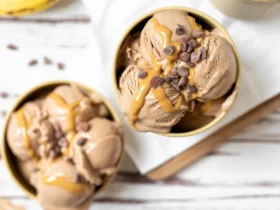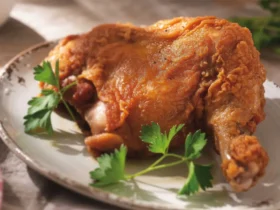You know that feeling when you bite into a biscuit and it’s just… sad? Dry, crumbly, and basically a puck of disappointment. I’ve been there, and it’s the worst.
But then there’s the other kind. The golden-brown, flaky, buttery kind that melts in your mouth and makes you close your eyes for a second. That’s the biscuit we’re making today.
I’m going to show you exactly how to make ridiculously good butter buttermilk biscuits from scratch. No hockey pucks, I promise. This is the recipe that will make you the official biscuit-maker for every family gathering from now on.
What You’ll Need
Getting the ingredients right is half the battle, seriously. Don’t just grab whatever from the pantry. The details here matter a whole lot, so let’s get specific.
The butter and buttermilk need to be cold. Not just cool from the fridge, I mean as cold as you can get them without being frozen solid. This is the secret.
| Ingredient | Amount |
|---|---|
| All-Purpose Flour | 2 ¾ cups |
| Baking Powder | 1 Tbsp |
| Granulated Sugar | 1 Tbsp |
| Baking Soda | ½ tsp |
| Fine Sea Salt | 1 tsp |
| Unsalted Butter | ½ cup (1 stick) |
| Full-Fat Buttermilk | 1 ¼ cups |
A quick note on brands. For flour, I usually just use the store brand or Gold Medal, nothing too fancy. But for butter, if you can find a good European-style butter like Kerrygold, it has a higher fat content and will make your biscuits taste incredible. It’s not a deal-breaker, but it’s a nice little upgrade.
Tools for the Job
You don’t need a bunch of high-tech gadgets for this. Biscuits are old-school, and so are the tools.
| Tool | Purpose |
|---|---|
| Large Bowl | For mixing |
| Pastry Blender or Box Grater | For the butter |
| 2 ½-inch Biscuit Cutter | For cutting |
| Baking Sheet | For baking |
| Pastry Brush | For the topping |
If you don’t have a pastry blender, you can use two knives or even just your fingertips. A box grater is actually my favorite secret weapon here—we’ll get to that. And please, don’t use a glass to cut your biscuits. It seals the edges and they won’t rise as high.
Pro Tips from My Kitchen
I’ve made thousands of biscuits, and I’ve made every mistake you can think of. Here are the three things that will save you from biscuit sadness.
-
Cold is King: I know I said it before, but I’m saying it again. Your butter and buttermilk must be ice cold. Cold butter creates little pockets in the dough. When that cold butter hits the hot oven, it releases steam, which pushes the dough up and creates those amazing flaky layers. I even put my stick of butter in the freezer for 15 minutes before I start. Some people even chill their flour. I don’t go that far, but it shows you how important temperature is.
-
Don’t Bully the Dough: This is the number one mistake people make. They overmix the dough. You want to handle it as little as humanly possible. When you add the buttermilk, you’re going to stir it just until the flour is mostly wet. It will look like a shaggy, ugly mess. That’s perfect. If you mix it until it’s smooth, you’ll develop the gluten in the flour and end up with tough, dense biscuits. Be gentle.
-
The Fold is Your Friend: To get those pull-apart layers, you need to do a couple of quick folds. After you dump the shaggy dough onto your counter, you’ll pat it into a rough rectangle and fold it over on itself like you’re folding a letter. Do this just two or three times. This creates layers of butter and dough, which is the secret to a perfect flaky biscuit. Any more than that, and you risk making them tough.
How to Make Butter Buttermilk Biscuits, Step-by-Step
Alright, let’s do this. Read through the steps once before you start, so you know what’s coming.
Step 1: Prep Your Oven and Pan
First thing’s first, get your oven preheating to 425°F (220°C). You want that oven screaming hot when the biscuits go in. Line a baking sheet with parchment paper. This just makes cleanup easier.
Step 2: Mix the Dry Stuff
In a large bowl, whisk together the all-purpose flour, baking powder, sugar, baking soda, and salt. Just give it a good mix for about 20 seconds to make sure everything is evenly spread out. You don’t want to bite into a clump of baking soda.
Step 3: Cut in the COLD Butter
Remember that frozen stick of butter? Grab it. Use the large holes on a box grater to grate the entire stick of butter directly into your bowl of dry ingredients. Then, use your fingertips to quickly toss the butter shreds with the flour until they’re all coated. It should look like coarse crumbs or shredded cheese. (This is way easier than using a pastry cutter, trust me).
Step 4: Add the Buttermilk
Pour in your cold buttermilk all at once. Use a fork or a rubber spatula to mix everything together until it just starts to come together. Remember, it’s going to look shaggy and unfinished. There might still be dry bits of flour at the bottom of the bowl. Stop mixing now.
Step 5: The Folds for Flakiness
Lightly flour your counter and dump the messy dough onto it. Scrape all the bits out of the bowl. Now, with floured hands, gently press the dough together into a rough rectangle, about 1 inch thick. Fold one side into the middle, then fold the other side over it, like a letter. Rotate the dough 90 degrees and gently pat it out again. Do this one more time. That’s it. Two folds total.
Step 6: Cut the Biscuits
Gently pat the dough out until it’s about ½ to ¾ inch thick. Don’t use a rolling pin unless you have to; the warmth from your hands is actually fine. Dip your 2 ½-inch biscuit cutter in some flour, then press it straight down into the dough. Do not twist the cutter. Twisting seals the edges and stops the rise. Cut out as many biscuits as you can and place them on your prepared baking sheet.
Step 7: Reroll the Scraps (Gently)
Gather the leftover dough scraps, press them together gently, and cut out more biscuits. These ones might not be quite as pretty as the first batch, but they’ll still taste amazing. I call them the chef’s snacks.
Step 8: The Finishing Touch and Bake
Place the biscuits on the baking sheet so they are just barely touching. This actually helps them rise taller. Brush the tops with a little bit of leftover buttermilk or some melted butter. This gives them that beautiful golden-brown color. Bake for 12-15 minutes, or until the tops are tall and golden brown. The whole kitchen will smell incredible.
Substitutions and Variations
Sometimes you don’t have exactly what a recipe calls for, and that’s okay. Here are a few swaps you can make.
- No Buttermilk? You can make a substitute in a pinch. For every 1 cup of milk (whole milk works best), stir in 1 tablespoon of either lemon juice or white vinegar. Let it sit for 5-10 minutes. It’ll look a little curdled, and that’s what you want.
- Herby Biscuits: Add about 2 tablespoons of chopped fresh herbs like chives, rosemary, or thyme to the dry ingredients. Cheddar and chives are a classic for a reason.
- Cheesy Biscuits: Add about ¾ cup of shredded sharp cheddar cheese to the dry ingredients along with the grated butter.
- Sweet Biscuits: You can add an extra tablespoon of sugar and a pinch of cinnamon. A little vanilla extract in the buttermilk works well too. Serve them with jam or honey butter.
Make-Ahead Tips
Life gets busy. The good news is you can prep these biscuits ahead of time.
You can make the dough, cut the biscuits, and place them on a baking sheet. Then, cover them and pop them in the refrigerator for up to 2 hours before baking.
For longer storage, you can freeze the unbaked, cut biscuits. Place them on a baking sheet in the freezer until they are solid. Then, transfer them to a freezer bag. They’ll keep for up to 2 months. You can bake them straight from frozen; just add about 5-8 minutes to the baking time.
Meal Pairing Suggestions
These biscuits are great on their own with a smear of butter, but they also play well with others.
They are the perfect partner for a classic sausage gravy. They’re also great for sopping up the sauce from a beef stew or a bowl of chili. I also love using them to make breakfast sandwiches with a fried egg, some bacon, and a slice of cheese. Or, serve them alongside a big salad for a simple lunch.
Leftovers and Storage
If you somehow have leftovers, you can store them in an airtight container at room temperature for up to 2 days. They tend to get a little dry, so here’s how to bring them back to life.
To reheat, just pop them in a 350°F oven for about 5 minutes. They’ll soften up and taste almost as good as new. Please don’t use the microwave unless you enjoy chewy, weirdly textured bread.
Nutritional Breakdown
Here’s a rough idea of the nutrition for one biscuit. This is just an estimate, so don’t take it as medical advice. It can change based on the exact ingredients you use.
- Calories: Around 250 kcal
- Carbohydrates: 30g
- Protein: 5g
- Fat: 12g
- Sodium: 450mg
Frequently Asked Questions
Q1. Why are my biscuits flat and hard?
Ans: You probably overworked the dough or your butter wasn’t cold enough. Be gentle when mixing and folding, and keep those ingredients chilly.
Q2. Can I use milk instead of buttermilk?
Ans: You can, but they won’t be as tender or have that classic tang. If you have to, use the milk-and-vinegar trick I mentioned in the substitutions section.
Q3. Why shouldn’t I twist the biscuit cutter?
Ans: Twisting the cutter pinches and seals the edges of the dough. This prevents the biscuit from rising to its full, flaky potential in the oven.
Q4. Can I use salted butter instead of unsalted?
Ans: Yes, but if you do, reduce the amount of salt you add to the dry ingredients by about half. Otherwise, your biscuits might be too salty.
Q5. My dough is super sticky. What did I do wrong?
Ans: Nothing! Buttermilk biscuit dough is supposed to be sticky and a little wet. Just make sure your hands and your work surface are well-floured when you handle it.
Wrapping Up
See? That wasn’t so scary. You are totally capable of making amazing, flaky, buttery biscuits that will make everyone think you’re some kind of baking genius. The secrets are simple: keep everything cold, and be gentle with the dough.
Now it’s your turn. Go make a batch and come back and tell me how they turned out. Did you add cheese? Did you serve them with gravy? I want to hear all about it in the comments below. And if you have any questions along the way, just ask.






Leave a Reply